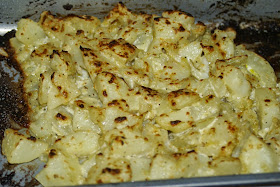
When fall rolls around, I get really excited to see pumpkins and other squash at the grocery store. Hello, delicious! One of my favorite ways to eat pumpkin is soup. Pumpkin soup is something I first encountered in Germany, and cannot get enough of. At least in Germany, it tends to be a savory, flavorful dish-- like most soups-- not liquid pumpkin pie (as a few of my friends have been disappointed to discover). I did recently have some that was less savory and had spices reminiscent of pumpkin pie, so I guess that's actually a decent assumption. But really, not very sweet liquid pumpkin pie struck me as a little bland, so I'll keep adding onions, salt, and plenty of flavor.
Last year I made it but never got a chance to post it to my blog. In that version, I used canned pumpkin puree (make sure it is pure pumpkin, NOT pumpkin pie filling!), an acorn squash, and about half of a butternut squash leftover from something else. This year I used a turban squash and about half of a pie pumpkin (don't use a jack-o'-lantern pumpkin-- they're too watery). That is the recipe that will be posted below.
Basically, use whatever winter squash or pumpkin you like-- it's a pretty flexible recipe.
Pumpkin-Squash Soup
1 turban squash
1/2 pie pumpkin
1/3 C chopped onion
2 medium carrots, chopped
2 stalks celery, chopped
1 clove garlic, minced
2 Tbsp oil or butter
1 qt chicken or vegetable stock
pinch of nutmeg
1/2 C milk or cream

Begin by prepping your squash/ pumpkin. If you can, it helps to break it down into halves or quarters. If you can't, poke it a few times with a knife to allow steam to vent while cooking. If using halves or quarters, scrape out the seeds. Place the squash (or pumpkin) in a shallow, microwave-safe dish and microwave about 5 minutes or so, until tender. If using quarters or halves, you may want to put a small amount of water in the dish as well, to prevent over-drying. A whole squash will likely need more time, but at this point it will be soft enough to break into pieces and scoop out the seeds.
After microwaving, do yourself as favor and let it cool. I usually use this time to prep my other veggies. Afterward, scoop out the flesh of the pumpkin/squash and set it aside. If you're using canned pumpkin, it's already at this stage.

In you soup pot, heat the oil or butter over medium-high heat and add the onion, garlic, carrots, and celery. Sauté about 5 minutes until onion is slightly browned. Add the squash and pumpkin, and allow to cook a few minutes more, until there is some browning of the squash/pumpkin. Add chicken stock and about
1 qt water. (You can use only water, but there is more flavor if you use stock; you can also use extra stock, I just usually have a quart of it frozen.) Season with
salt and pepper. Bring the soup to a boil, then reduce it to a simmer. Allow the soup to simmer about half an hour (or longer, if you like) so that everything is super-tender and the flavors are all well-integrated.
Remove from heat. If you've got an immersion blender (I highly recommend having one; my mom thinks they're under-powered and over-rated, but I've used mine for everything from chocolate-tempering to smoothies, and it just saves so much time when making soups.) you can immediately puree the soup. If you have a traditional blender or food processor, you NEED to let the soup cool. You can rig a cooling set-up to speed it along a bit, but it's going to be a big time sink. Puree the soup to an even texture. (The sneaky carrots will try to avoid you!)
Return the soup to low heat and allow to heat up. Add the milk and nutmeg, and check your salt/pepper seasoning again. Enjoy!
 Some other variations on this include adding apples and/or potatoes. The latter makes for a more substantial soup, but means you'll certainly want to add more salt and pepper. The apple can contribute flavor-- a little bit of sweetness or tartness, depending on what type (I prefer a more tart apple). Using yogurt or sour cream can also be a nice substation for milk, adding a little bit of tanginess.
Some other variations on this include adding apples and/or potatoes. The latter makes for a more substantial soup, but means you'll certainly want to add more salt and pepper. The apple can contribute flavor-- a little bit of sweetness or tartness, depending on what type (I prefer a more tart apple). Using yogurt or sour cream can also be a nice substation for milk, adding a little bit of tanginess.
My husband thought it was a tad bland, but good. I think I might have needed a bit more salt and pepper. I might try adding some diced ham for his benefit, too. Curry would also go nicely, and give it another layer of warmth.
As I stated in the beginning, I wait all year for this. I love making pumpkin/squash soup. Also, since everything is pureed, it freezes well. If you are going to freeze it, do so before adding the milk; it can separate oddly after freezing.
 Crispy Cream-Braised Potatoes and Fennel
Crispy Cream-Braised Potatoes and Fennel 1 pinch lemon zest
1 pinch lemon zest





















